Business Culture & Change: People Practice in Organizational Context
VerifiedAdded on 2023/06/18
|9
|1652
|419
Essay
AI Summary
This essay explores the critical aspects of business culture and change management within organizations, emphasizing the significance of fostering a positive workplace culture to enhance employee retention and overall performance. It discusses how organizations function as interconnected systems where elements like culture, structure, and teams influence each other to achieve business goals. The essay highlights the impact of people practices, both positive and negative, on various parts of the organization, using The Araki restaurant as a case study. It also examines different individual learning styles and the importance of tailoring assessment methods accordingly. Furthermore, the essay underscores the necessity of planning, predicting, and managing change effectively, along with the crucial roles of people practice professionals in change implementation. Finally, it acknowledges the diverse ways change affects individuals and stresses the importance of understanding these impacts for successful change management.
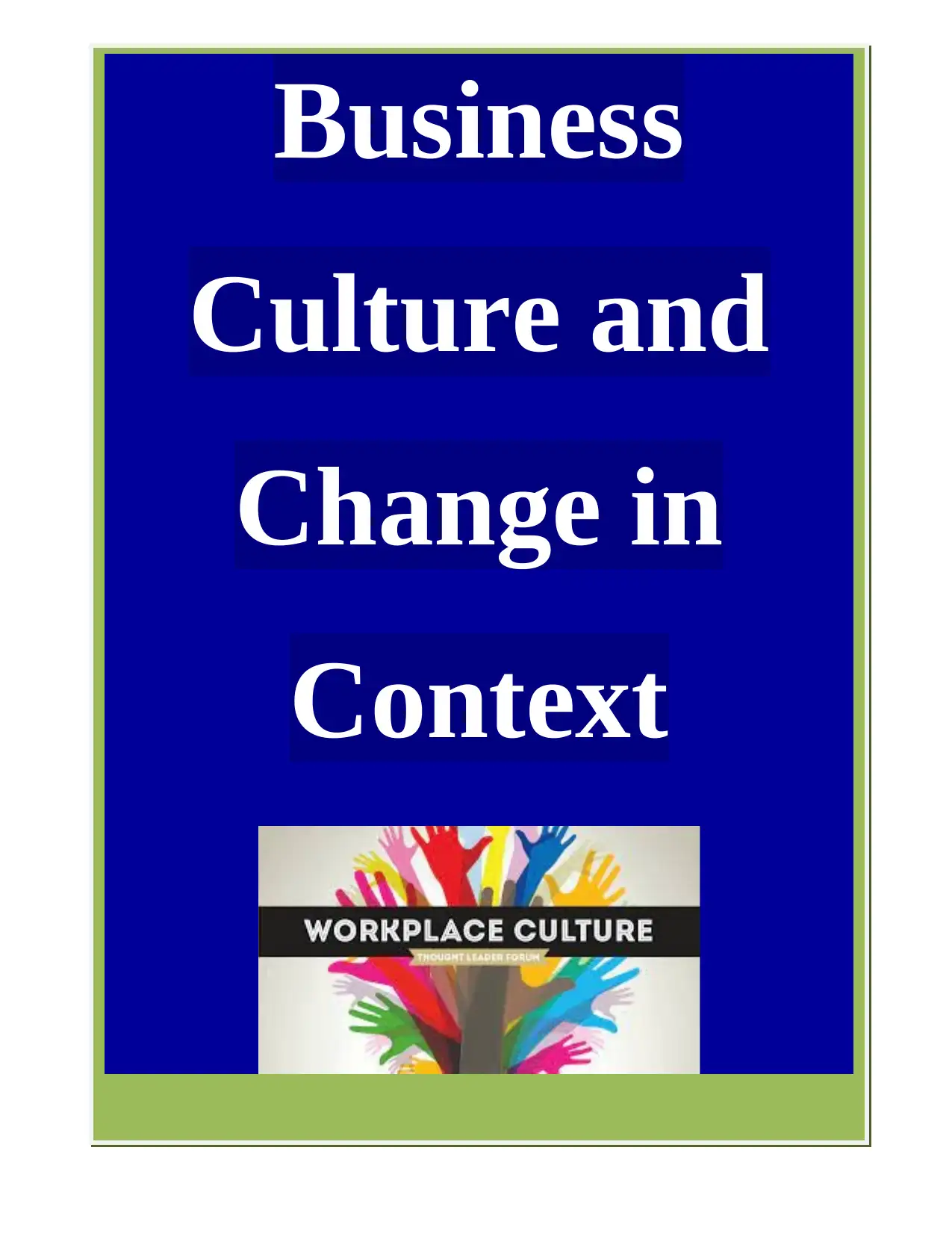
Business
Culture and
Change in
Context
Culture and
Change in
Context
Paraphrase This Document
Need a fresh take? Get an instant paraphrase of this document with our AI Paraphraser
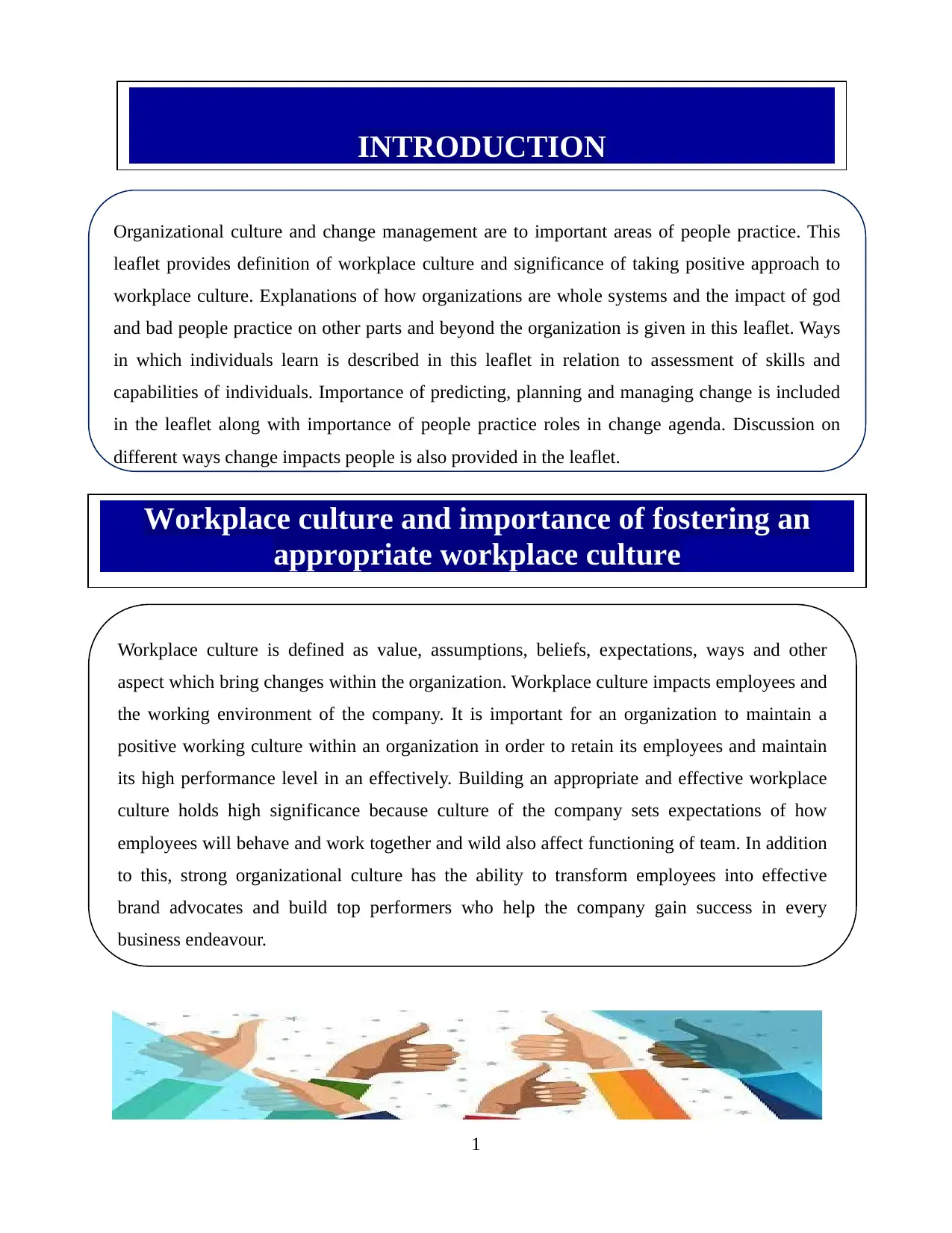
1
INTRODUCTION
Organizational culture and change management are to important areas of people practice. This
leaflet provides definition of workplace culture and significance of taking positive approach to
workplace culture. Explanations of how organizations are whole systems and the impact of god
and bad people practice on other parts and beyond the organization is given in this leaflet. Ways
in which individuals learn is described in this leaflet in relation to assessment of skills and
capabilities of individuals. Importance of predicting, planning and managing change is included
in the leaflet along with importance of people practice roles in change agenda. Discussion on
different ways change impacts people is also provided in the leaflet.
Workplace culture and importance of fostering an
appropriate workplace culture
Workplace culture is defined as value, assumptions, beliefs, expectations, ways and other
aspect which bring changes within the organization. Workplace culture impacts employees and
the working environment of the company. It is important for an organization to maintain a
positive working culture within an organization in order to retain its employees and maintain
its high performance level in an effectively. Building an appropriate and effective workplace
culture holds high significance because culture of the company sets expectations of how
employees will behave and work together and wild also affect functioning of team. In addition
to this, strong organizational culture has the ability to transform employees into effective
brand advocates and build top performers who help the company gain success in every
business endeavour.
INTRODUCTION
Organizational culture and change management are to important areas of people practice. This
leaflet provides definition of workplace culture and significance of taking positive approach to
workplace culture. Explanations of how organizations are whole systems and the impact of god
and bad people practice on other parts and beyond the organization is given in this leaflet. Ways
in which individuals learn is described in this leaflet in relation to assessment of skills and
capabilities of individuals. Importance of predicting, planning and managing change is included
in the leaflet along with importance of people practice roles in change agenda. Discussion on
different ways change impacts people is also provided in the leaflet.
Workplace culture and importance of fostering an
appropriate workplace culture
Workplace culture is defined as value, assumptions, beliefs, expectations, ways and other
aspect which bring changes within the organization. Workplace culture impacts employees and
the working environment of the company. It is important for an organization to maintain a
positive working culture within an organization in order to retain its employees and maintain
its high performance level in an effectively. Building an appropriate and effective workplace
culture holds high significance because culture of the company sets expectations of how
employees will behave and work together and wild also affect functioning of team. In addition
to this, strong organizational culture has the ability to transform employees into effective
brand advocates and build top performers who help the company gain success in every
business endeavour.
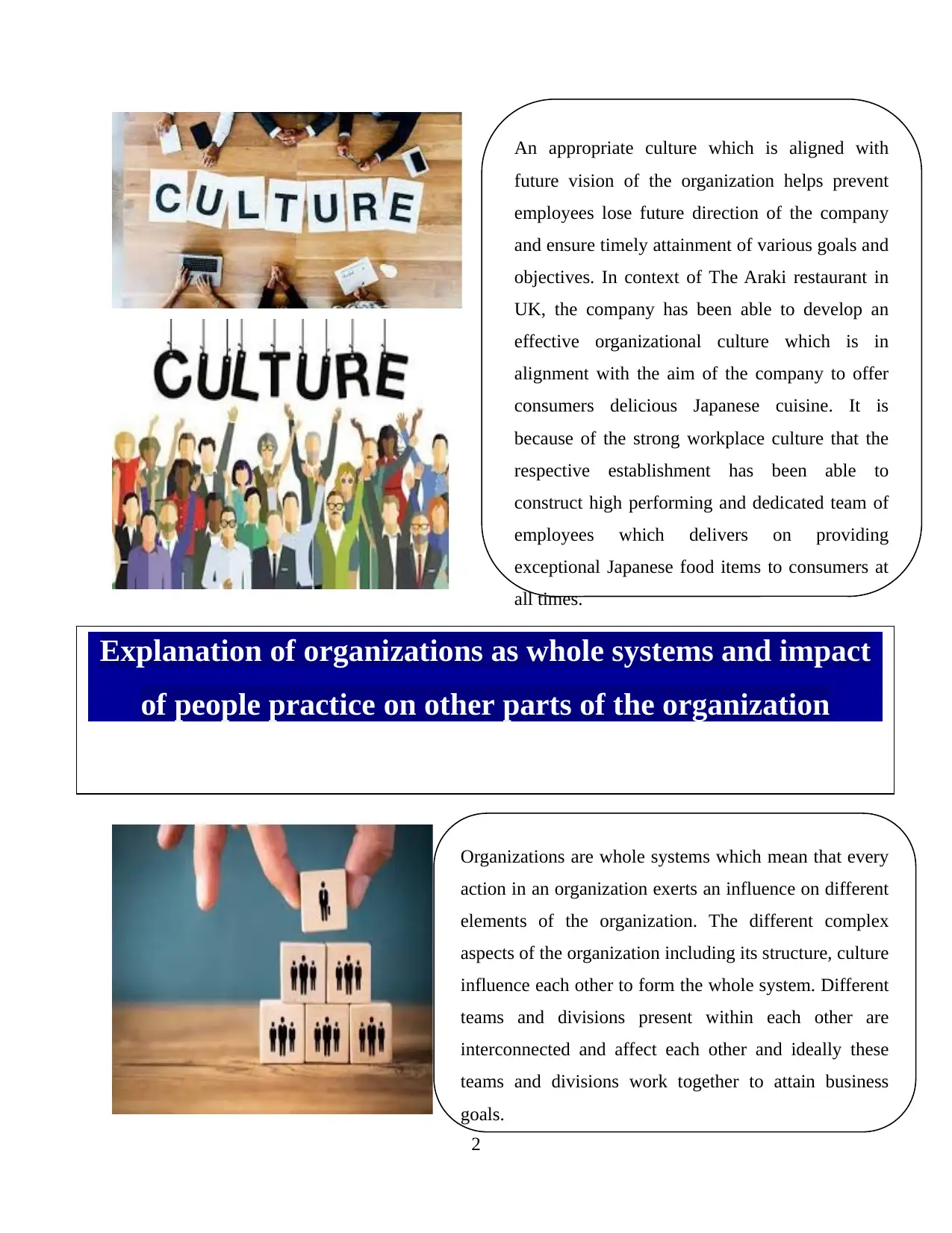
2
An appropriate culture which is aligned with
future vision of the organization helps prevent
employees lose future direction of the company
and ensure timely attainment of various goals and
objectives. In context of The Araki restaurant in
UK, the company has been able to develop an
effective organizational culture which is in
alignment with the aim of the company to offer
consumers delicious Japanese cuisine. It is
because of the strong workplace culture that the
respective establishment has been able to
construct high performing and dedicated team of
employees which delivers on providing
exceptional Japanese food items to consumers at
all times.
Explanation of organizations as whole systems and impact
of people practice on other parts of the organization
Organizations are whole systems which mean that every
action in an organization exerts an influence on different
elements of the organization. The different complex
aspects of the organization including its structure, culture
influence each other to form the whole system. Different
teams and divisions present within each other are
interconnected and affect each other and ideally these
teams and divisions work together to attain business
goals.
An appropriate culture which is aligned with
future vision of the organization helps prevent
employees lose future direction of the company
and ensure timely attainment of various goals and
objectives. In context of The Araki restaurant in
UK, the company has been able to develop an
effective organizational culture which is in
alignment with the aim of the company to offer
consumers delicious Japanese cuisine. It is
because of the strong workplace culture that the
respective establishment has been able to
construct high performing and dedicated team of
employees which delivers on providing
exceptional Japanese food items to consumers at
all times.
Explanation of organizations as whole systems and impact
of people practice on other parts of the organization
Organizations are whole systems which mean that every
action in an organization exerts an influence on different
elements of the organization. The different complex
aspects of the organization including its structure, culture
influence each other to form the whole system. Different
teams and divisions present within each other are
interconnected and affect each other and ideally these
teams and divisions work together to attain business
goals.
⊘ This is a preview!⊘
Do you want full access?
Subscribe today to unlock all pages.

Trusted by 1+ million students worldwide
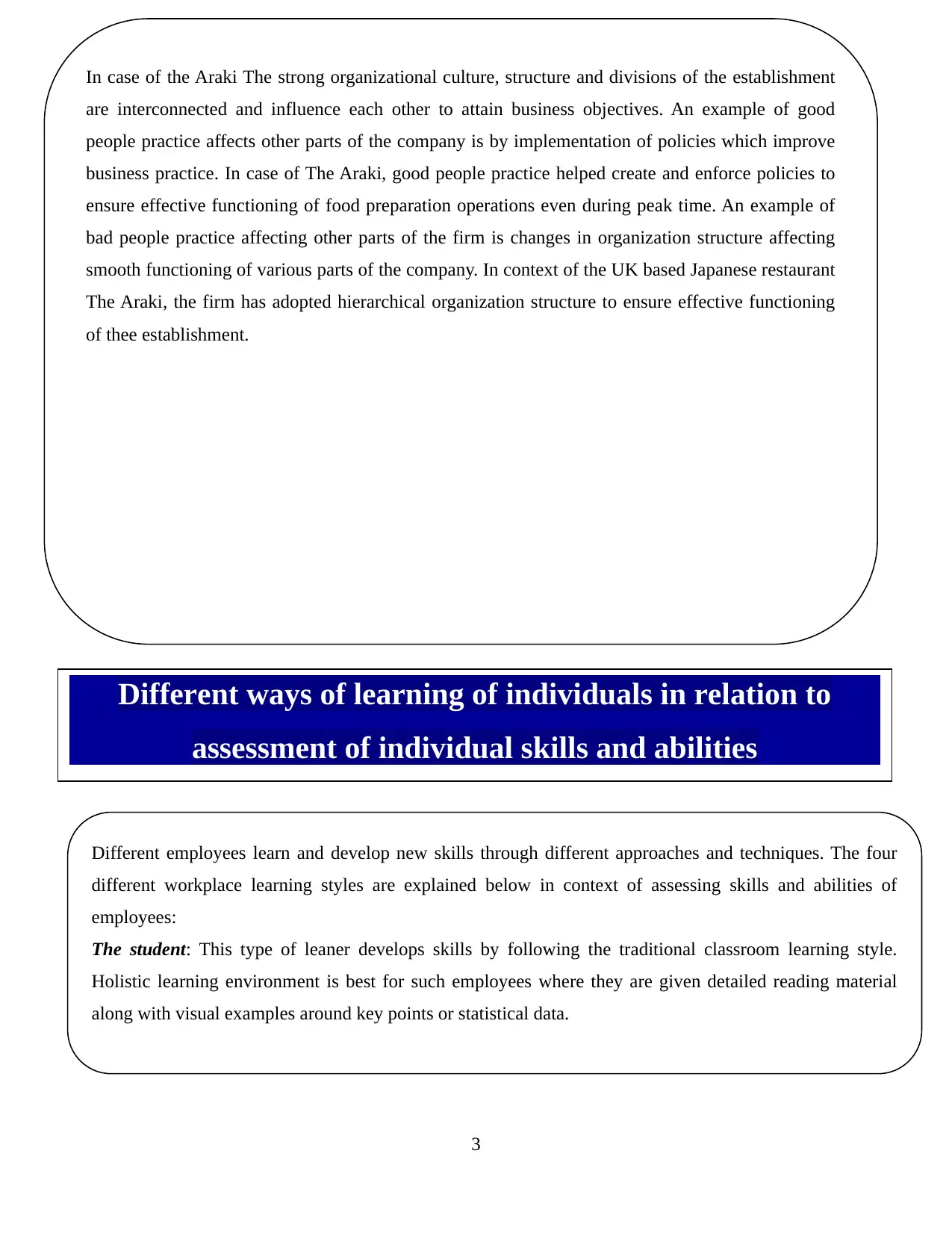
3
In case of the Araki The strong organizational culture, structure and divisions of the establishment
are interconnected and influence each other to attain business objectives. An example of good
people practice affects other parts of the company is by implementation of policies which improve
business practice. In case of The Araki, good people practice helped create and enforce policies to
ensure effective functioning of food preparation operations even during peak time. An example of
bad people practice affecting other parts of the firm is changes in organization structure affecting
smooth functioning of various parts of the company. In context of the UK based Japanese restaurant
The Araki, the firm has adopted hierarchical organization structure to ensure effective functioning
of thee establishment.
Different ways of learning of individuals in relation to
assessment of individual skills and abilities
Different employees learn and develop new skills through different approaches and techniques. The four
different workplace learning styles are explained below in context of assessing skills and abilities of
employees:
The student: This type of leaner develops skills by following the traditional classroom learning style.
Holistic learning environment is best for such employees where they are given detailed reading material
along with visual examples around key points or statistical data.
In case of the Araki The strong organizational culture, structure and divisions of the establishment
are interconnected and influence each other to attain business objectives. An example of good
people practice affects other parts of the company is by implementation of policies which improve
business practice. In case of The Araki, good people practice helped create and enforce policies to
ensure effective functioning of food preparation operations even during peak time. An example of
bad people practice affecting other parts of the firm is changes in organization structure affecting
smooth functioning of various parts of the company. In context of the UK based Japanese restaurant
The Araki, the firm has adopted hierarchical organization structure to ensure effective functioning
of thee establishment.
Different ways of learning of individuals in relation to
assessment of individual skills and abilities
Different employees learn and develop new skills through different approaches and techniques. The four
different workplace learning styles are explained below in context of assessing skills and abilities of
employees:
The student: This type of leaner develops skills by following the traditional classroom learning style.
Holistic learning environment is best for such employees where they are given detailed reading material
along with visual examples around key points or statistical data.
Paraphrase This Document
Need a fresh take? Get an instant paraphrase of this document with our AI Paraphraser
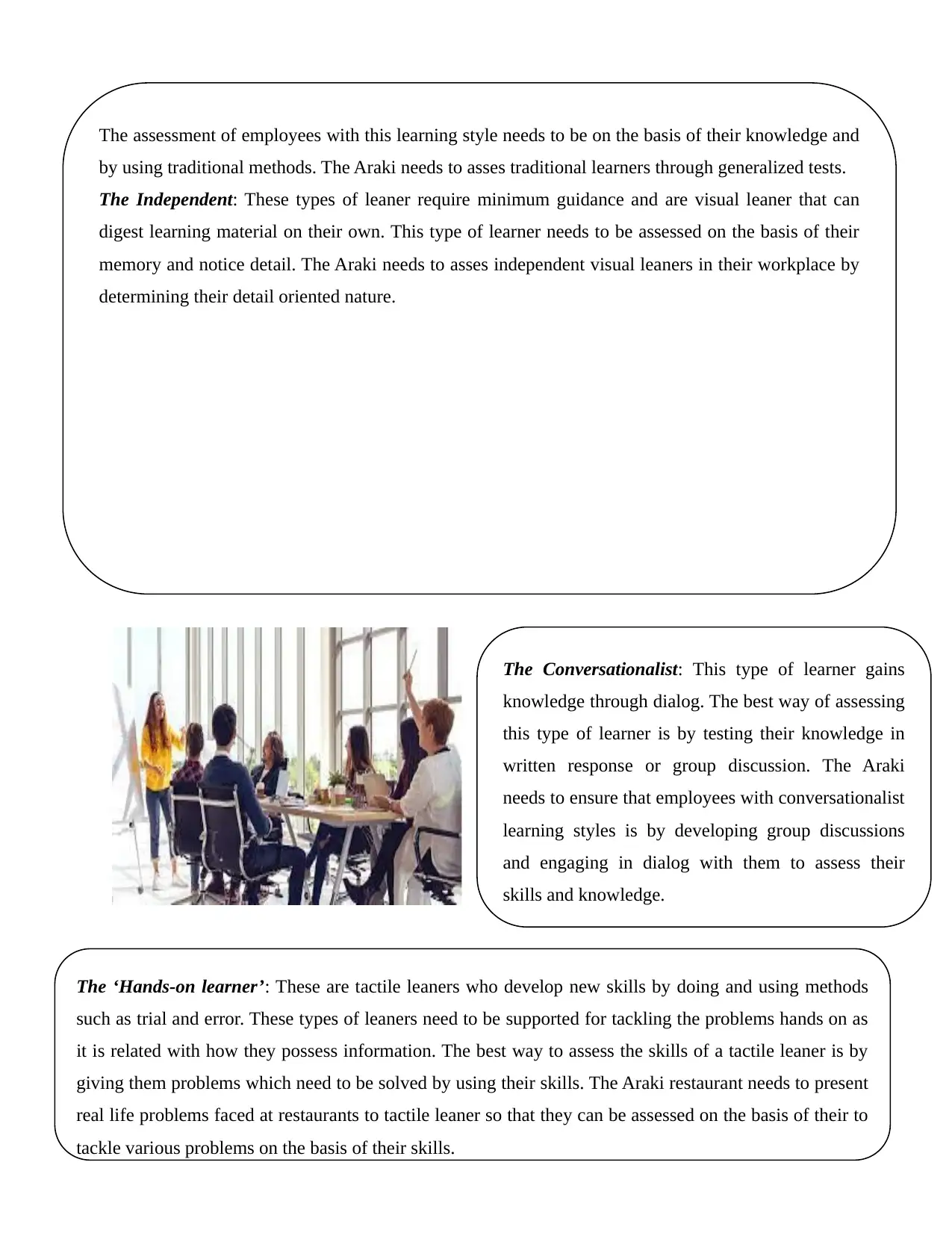
4
The assessment of employees with this learning style needs to be on the basis of their knowledge and
by using traditional methods. The Araki needs to asses traditional learners through generalized tests.
The Independent: These types of leaner require minimum guidance and are visual leaner that can
digest learning material on their own. This type of learner needs to be assessed on the basis of their
memory and notice detail. The Araki needs to asses independent visual leaners in their workplace by
determining their detail oriented nature.
The Conversationalist: This type of learner gains
knowledge through dialog. The best way of assessing
this type of learner is by testing their knowledge in
written response or group discussion. The Araki
needs to ensure that employees with conversationalist
learning styles is by developing group discussions
and engaging in dialog with them to assess their
skills and knowledge.
The ‘Hands-on learner’: These are tactile leaners who develop new skills by doing and using methods
such as trial and error. These types of leaners need to be supported for tackling the problems hands on as
it is related with how they possess information. The best way to assess the skills of a tactile leaner is by
giving them problems which need to be solved by using their skills. The Araki restaurant needs to present
real life problems faced at restaurants to tactile leaner so that they can be assessed on the basis of their to
tackle various problems on the basis of their skills.
4
The assessment of employees with this learning style needs to be on the basis of their knowledge and
by using traditional methods. The Araki needs to asses traditional learners through generalized tests.
The Independent: These types of leaner require minimum guidance and are visual leaner that can
digest learning material on their own. This type of learner needs to be assessed on the basis of their
memory and notice detail. The Araki needs to asses independent visual leaners in their workplace by
determining their detail oriented nature.
The Conversationalist: This type of learner gains
knowledge through dialog. The best way of assessing
this type of learner is by testing their knowledge in
written response or group discussion. The Araki
needs to ensure that employees with conversationalist
learning styles is by developing group discussions
and engaging in dialog with them to assess their
skills and knowledge.
The ‘Hands-on learner’: These are tactile leaners who develop new skills by doing and using methods
such as trial and error. These types of leaners need to be supported for tackling the problems hands on as
it is related with how they possess information. The best way to assess the skills of a tactile leaner is by
giving them problems which need to be solved by using their skills. The Araki restaurant needs to present
real life problems faced at restaurants to tactile leaner so that they can be assessed on the basis of their to
tackle various problems on the basis of their skills.
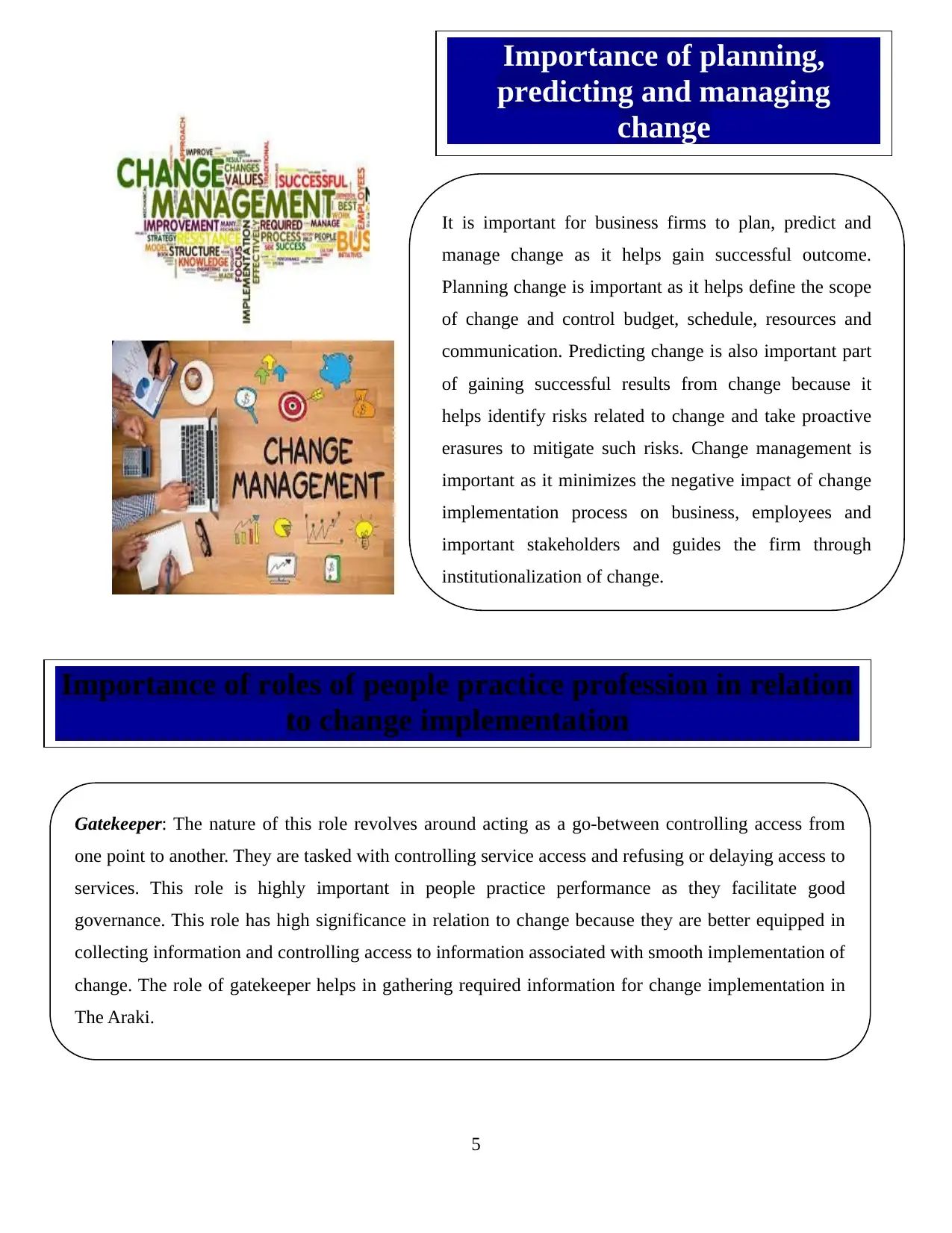
5
Importance of planning,
predicting and managing
change
It is important for business firms to plan, predict and
manage change as it helps gain successful outcome.
Planning change is important as it helps define the scope
of change and control budget, schedule, resources and
communication. Predicting change is also important part
of gaining successful results from change because it
helps identify risks related to change and take proactive
erasures to mitigate such risks. Change management is
important as it minimizes the negative impact of change
implementation process on business, employees and
important stakeholders and guides the firm through
institutionalization of change.
Importance of roles of people practice profession in relation
to change implementation
Gatekeeper: The nature of this role revolves around acting as a go-between controlling access from
one point to another. They are tasked with controlling service access and refusing or delaying access to
services. This role is highly important in people practice performance as they facilitate good
governance. This role has high significance in relation to change because they are better equipped in
collecting information and controlling access to information associated with smooth implementation of
change. The role of gatekeeper helps in gathering required information for change implementation in
The Araki.
Importance of planning,
predicting and managing
change
It is important for business firms to plan, predict and
manage change as it helps gain successful outcome.
Planning change is important as it helps define the scope
of change and control budget, schedule, resources and
communication. Predicting change is also important part
of gaining successful results from change because it
helps identify risks related to change and take proactive
erasures to mitigate such risks. Change management is
important as it minimizes the negative impact of change
implementation process on business, employees and
important stakeholders and guides the firm through
institutionalization of change.
Importance of roles of people practice profession in relation
to change implementation
Gatekeeper: The nature of this role revolves around acting as a go-between controlling access from
one point to another. They are tasked with controlling service access and refusing or delaying access to
services. This role is highly important in people practice performance as they facilitate good
governance. This role has high significance in relation to change because they are better equipped in
collecting information and controlling access to information associated with smooth implementation of
change. The role of gatekeeper helps in gathering required information for change implementation in
The Araki.
⊘ This is a preview!⊘
Do you want full access?
Subscribe today to unlock all pages.

Trusted by 1+ million students worldwide
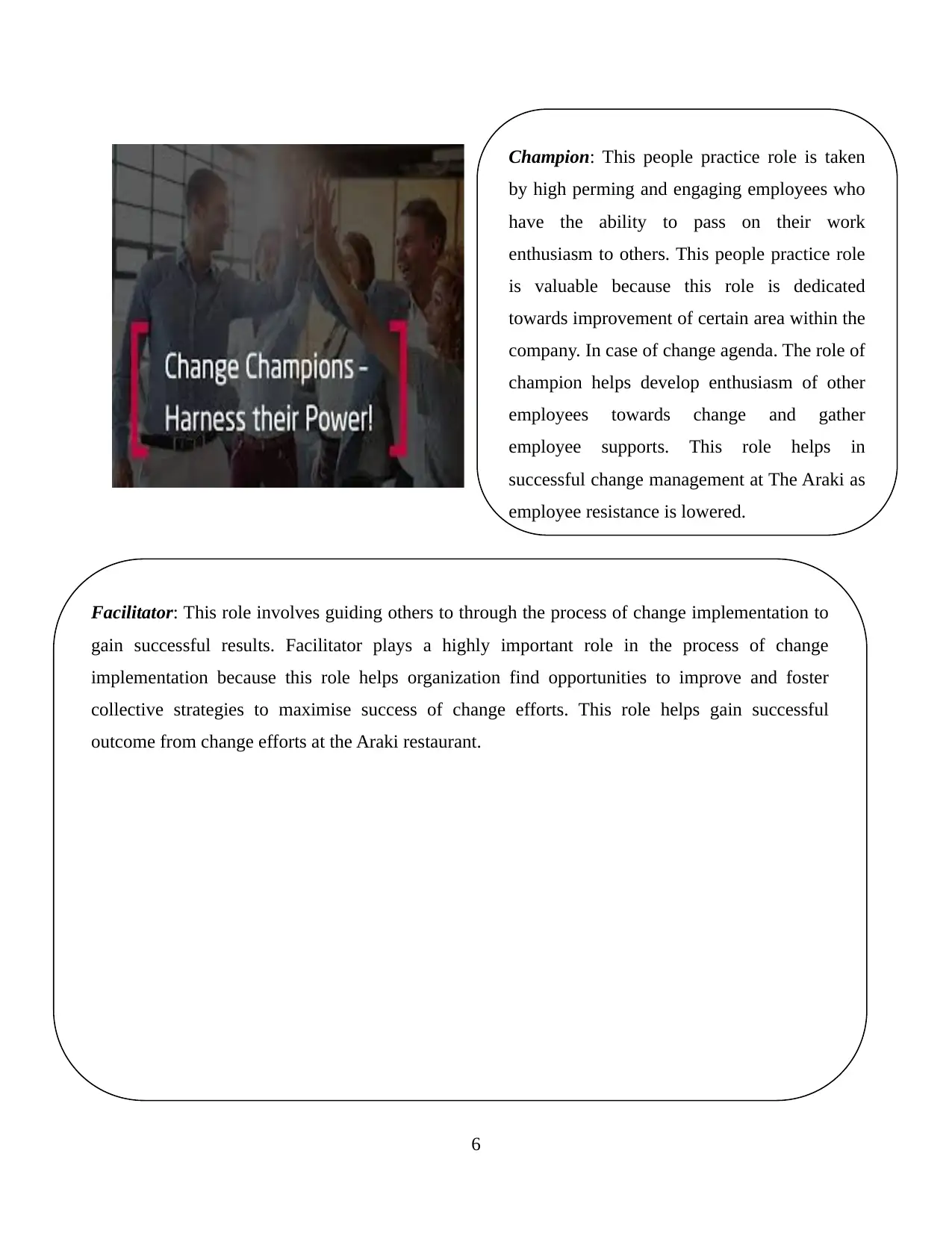
6
Champion: This people practice role is taken
by high perming and engaging employees who
have the ability to pass on their work
enthusiasm to others. This people practice role
is valuable because this role is dedicated
towards improvement of certain area within the
company. In case of change agenda. The role of
champion helps develop enthusiasm of other
employees towards change and gather
employee supports. This role helps in
successful change management at The Araki as
employee resistance is lowered.
Facilitator: This role involves guiding others to through the process of change implementation to
gain successful results. Facilitator plays a highly important role in the process of change
implementation because this role helps organization find opportunities to improve and foster
collective strategies to maximise success of change efforts. This role helps gain successful
outcome from change efforts at the Araki restaurant.
Champion: This people practice role is taken
by high perming and engaging employees who
have the ability to pass on their work
enthusiasm to others. This people practice role
is valuable because this role is dedicated
towards improvement of certain area within the
company. In case of change agenda. The role of
champion helps develop enthusiasm of other
employees towards change and gather
employee supports. This role helps in
successful change management at The Araki as
employee resistance is lowered.
Facilitator: This role involves guiding others to through the process of change implementation to
gain successful results. Facilitator plays a highly important role in the process of change
implementation because this role helps organization find opportunities to improve and foster
collective strategies to maximise success of change efforts. This role helps gain successful
outcome from change efforts at the Araki restaurant.
Paraphrase This Document
Need a fresh take? Get an instant paraphrase of this document with our AI Paraphraser
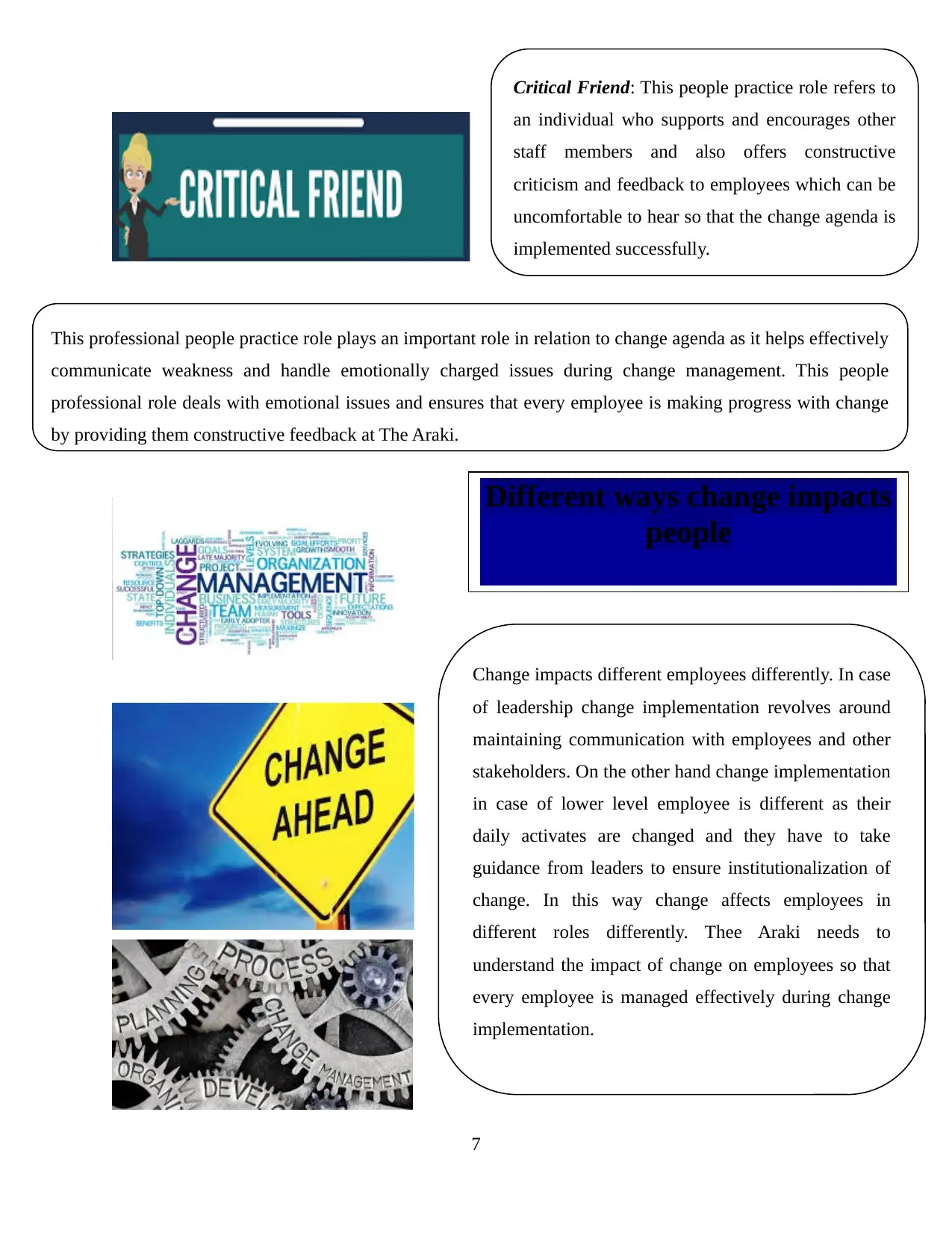
7
Critical Friend: This people practice role refers to
an individual who supports and encourages other
staff members and also offers constructive
criticism and feedback to employees which can be
uncomfortable to hear so that the change agenda is
implemented successfully.
This professional people practice role plays an important role in relation to change agenda as it helps effectively
communicate weakness and handle emotionally charged issues during change management. This people
professional role deals with emotional issues and ensures that every employee is making progress with change
by providing them constructive feedback at The Araki.
Different ways change impacts
people
Change impacts different employees differently. In case
of leadership change implementation revolves around
maintaining communication with employees and other
stakeholders. On the other hand change implementation
in case of lower level employee is different as their
daily activates are changed and they have to take
guidance from leaders to ensure institutionalization of
change. In this way change affects employees in
different roles differently. Thee Araki needs to
understand the impact of change on employees so that
every employee is managed effectively during change
implementation.
Critical Friend: This people practice role refers to
an individual who supports and encourages other
staff members and also offers constructive
criticism and feedback to employees which can be
uncomfortable to hear so that the change agenda is
implemented successfully.
This professional people practice role plays an important role in relation to change agenda as it helps effectively
communicate weakness and handle emotionally charged issues during change management. This people
professional role deals with emotional issues and ensures that every employee is making progress with change
by providing them constructive feedback at The Araki.
Different ways change impacts
people
Change impacts different employees differently. In case
of leadership change implementation revolves around
maintaining communication with employees and other
stakeholders. On the other hand change implementation
in case of lower level employee is different as their
daily activates are changed and they have to take
guidance from leaders to ensure institutionalization of
change. In this way change affects employees in
different roles differently. Thee Araki needs to
understand the impact of change on employees so that
every employee is managed effectively during change
implementation.
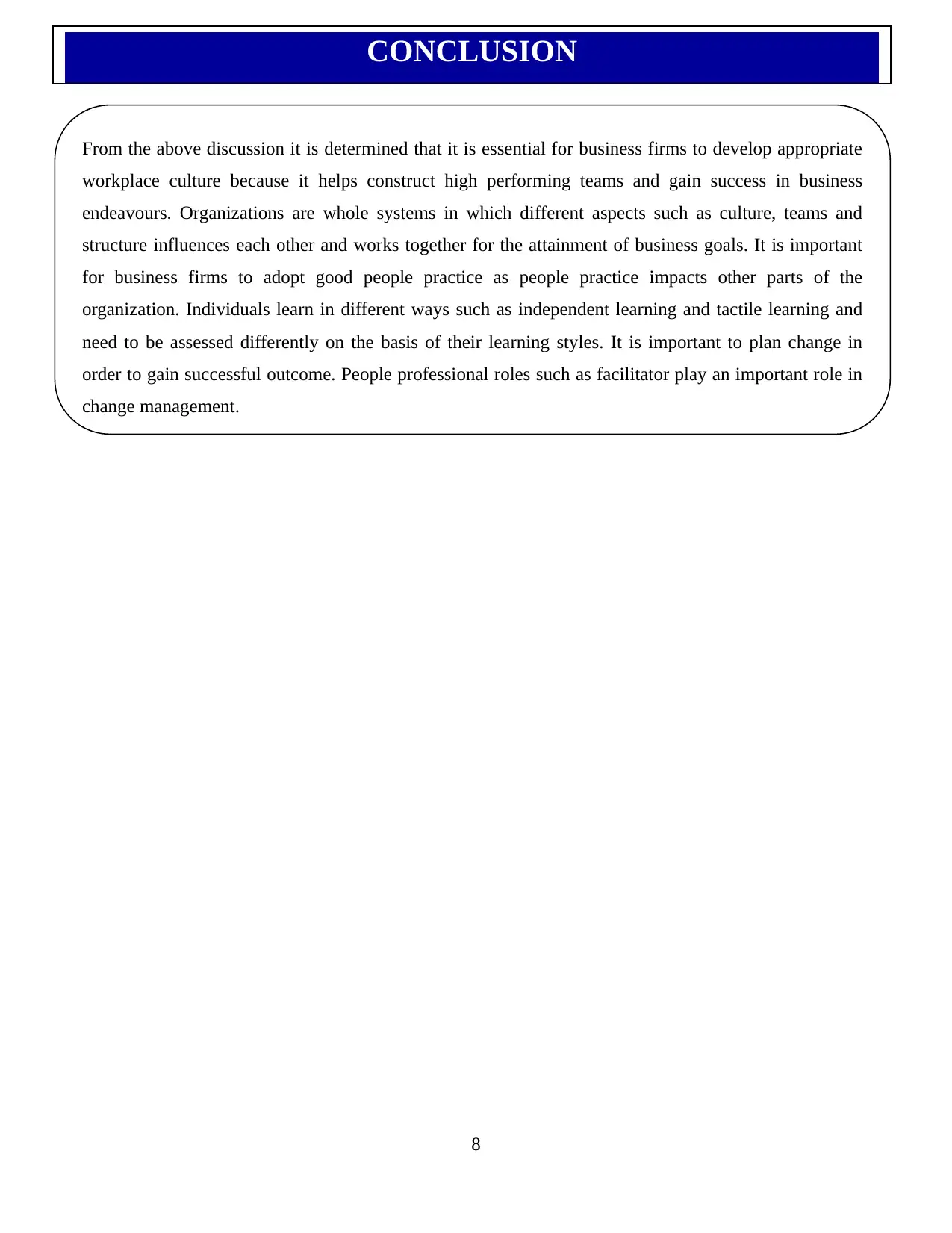
8
CONCLUSION
From the above discussion it is determined that it is essential for business firms to develop appropriate
workplace culture because it helps construct high performing teams and gain success in business
endeavours. Organizations are whole systems in which different aspects such as culture, teams and
structure influences each other and works together for the attainment of business goals. It is important
for business firms to adopt good people practice as people practice impacts other parts of the
organization. Individuals learn in different ways such as independent learning and tactile learning and
need to be assessed differently on the basis of their learning styles. It is important to plan change in
order to gain successful outcome. People professional roles such as facilitator play an important role in
change management.
CONCLUSION
From the above discussion it is determined that it is essential for business firms to develop appropriate
workplace culture because it helps construct high performing teams and gain success in business
endeavours. Organizations are whole systems in which different aspects such as culture, teams and
structure influences each other and works together for the attainment of business goals. It is important
for business firms to adopt good people practice as people practice impacts other parts of the
organization. Individuals learn in different ways such as independent learning and tactile learning and
need to be assessed differently on the basis of their learning styles. It is important to plan change in
order to gain successful outcome. People professional roles such as facilitator play an important role in
change management.
⊘ This is a preview!⊘
Do you want full access?
Subscribe today to unlock all pages.

Trusted by 1+ million students worldwide
1 out of 9
Related Documents
Your All-in-One AI-Powered Toolkit for Academic Success.
+13062052269
info@desklib.com
Available 24*7 on WhatsApp / Email
![[object Object]](/_next/static/media/star-bottom.7253800d.svg)
Unlock your academic potential
Copyright © 2020–2025 A2Z Services. All Rights Reserved. Developed and managed by ZUCOL.




